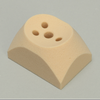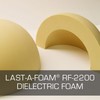HOW TOOLING IMPACTS PRODUCT QUALITY
Featured Product from General Plastics Manufacturing Co.
HOW DOES TOOLING IMPACT PRODUCT QUALITY, BUDGETS, AND TIMELINES?
Tooling is a key technology used in aerospace, automotive, and other major industries to manufacture parts or components. Different types of tooling include work holding tools, jigs and fixtures, and mandrels for thermoforming. Your choice of tooling can significantly impact everything from product quality, to budget costs, and project timelines.
Product Quality
A tool functions by transferring its form to the production article; in other words, it determines the final shape of the finished product. Different tooling types will have different dimensional tolerance levels, mostly affected by the coefficients of thermal expansion (CTEs) for the tooling material and production material. By matching their CTE values, both materials will expand and contract at the same rates when exposed to varying curing temperatures – resulting in high-quality parts with very precise dimensional tolerances. For example, metallic tooling is commonly used for products that need dimensional accuracy of 1/5000th of an inch or less.
The surface finish of the tooling material will also be imprinted onto the finished part. Therefore consideration must be made based on the desired smoothness of the production article. For high-density urethane (HDU) tooling board, a higher density foam will not only increase modulus and strength, but also reduce the surface porosity for greater smoothness due to its close-packed cells.
Ultimately, the curing process for the manufactured component will determine what tooling materials are eligible, based on temperature, pressure, and the number of autoclave cycles. Hard tooling is necessary for the most demanding curing conditions, tight tolerances and a larger number of pulls, while soft tooling may be more cost-effective for prototype or interim tooling options.
Budget Costs
There is far more to tooling expenses than just the initial price of the raw materials. Certain materials have greater hardness, which increases the longevity of the tool. However, it also increases the cost of machining, processing, and reworking the tool. Depending on the production rate and expected wear and tear on the tool, it may be more cost-effective to buy one metal tool or to use foam tooling with several replacements.
The weight of the tool can also have an unanticipated impact on the budget. If the tool is especially large and heavy, additional manpower and resources are needed to handle and maneuver it around a factory floor. Plus, if the tool must be transported to different manufacturing facilities, shipping a heavier metal tool versus a lighter polyurethane foam tool will have different costs.
Project Timelines
Time is money, and selecting the right tool can shorten your R&D cycles and get your product to market faster. As mentioned before, matching CTEs in the tooling and production material is important, especially in cases where high-temperature processing is needed. When the tooling material has a higher CTE, additional design time for CTE compensation is needed to make sure the thermal expansion rate of the tool does not adversely affect the part. The user must also consider the thermal cycle required to cure a part. For example, since soft tooling is a poor conductor of heat, longer cycles may be required to achieve the desired cure of the laminate.
Material lead time and machine time are usually the most significant factors in the overall project time. Common materials like HDU foam and steel are readily available, whereas premium metals like Invar nickel-iron alloy can have shortages and long lead times. Compared to hard tooling, soft tooling is easier and faster to machine into complex shapes, which is beneficial for prototyping and other time-sensitive projects. Plus, it can be quickly reworked or modified if needed.
Making the Right Tooling Choice
Your choice of tooling material can affect product quality, design production costs, and on-time project completion. Depending on your project requirements, it may be appropriate to use durable hard tooling for a long-lasting, high-volume program or cost-effective soft tooling for time-sensitive, short-run productions.
Follow us on:
Use our Product Finder tool to find out what product is suitable for your specific application.
RIGID & FLEXIBLE POLYURETHANE FOAM AND BUILD-TO-PRINT COMPOSITE PARTS
For over 75 years, we have focused on meeting the exacting requirements of engineers and design teams in diverse industries. Our premier LAST-A-FOAM® closed- and open-cell polyurethane foam products provide a high strength-to-weight ratio and extraordinary versatility, with absolute consistency from order to order, guaranteed.
Whether you need high-temperature tooling boards, molded parts or submersible foams, expect identical quality, uniformity, stability and weight for the density you specify – every time.
From the oceans’ depths to deep space, we shape great ideas into reality.





